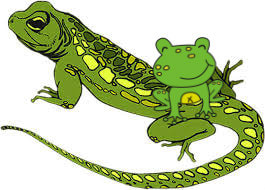reptiles, snakes specifically, have gotten a raw deal through the centuries. They're associated with dark magic, voodoo, and the like. They are used as symbols for the devil. Kids either love them or are terrified by them. However children feel about them as youngsters, that love or fear usually stay with them into adulthood. I knew one human who was so terrified of snakes, she couldn't even look at a photograph of one in a magazine like National Geographic without coming close to fainting. Herpetophobia is a fear of reptiles while ophidiophobia is specifically the abnormal fear of snakes.
So exactly what critters are classified as reptiles? I'm so glad you asked! Turtles, for one. Others include crocodilians, snakes, lizards, tuatara, and amphisbaenians. With today's blog, I'm hoping to help lessen some fears by introducing you to a few cool facts about our reptile friends.
1. Everyone thinks snakes are one of the oldest creatures on earth. Truth is, reptiles evolved from amphibians. This is a bit over-simplistic but "it is fair to say that fish evolved into tetrapods, tetrapods evolved into amphibians, and amphibians evolved into reptiles—all of these events taking place between 400 and 300 million years ago. And that's not the end of the story: About 200 million years ago, the reptiles we know as therapsids evolved into mammals (at the same time the reptiles we know as archosaurs evolved into dinosaurs), and another 50 million years after that, the reptiles we know as dinosaurs evolved into birds. This "in-betweenness" of reptiles may help to explain their relative scarcity today, as their more evolved descendants out-compete them in various ecological niches."
2. You can count the varieties of reptile alive today on one hand: turtles, which are characterized by their slow metabolisms and protective shells; squamates, including snakes and lizards, which shed their skins and have wide-opening jaws; crocodilians, which are the closest living relatives of both modern birds and extinct dinosaurs; and the strange creatures known as tuataras, which today are restricted to a few remote islands of New Zealand.
3. All reptiles are cold-blooded animals. One of the main characteristics that distinguish reptiles from mammals and birds is that they're ectothermic, or "cold-blooded," relying on external weather conditions to power their internal physiology. Snakes and crocodiles literally "fuel up" by basking in the sun during the day, and are especially sluggish at night, when there's no available energy source. The advantage of ectothermic metabolisms is that reptiles need to eat much less than comparably sized birds and mammals. The disadvantage is that they're unable to sustain a consistently high level of activity, especially when it's dark.
4. All reptiles have scaly skin. Body lotion, anyone? But seriously, the rough, vaguely alien quality of reptilian skin makes some people uneasy, but the fact is that these scales represent a major evolutionary leap. Snakes shed their skin all in one piece, while others shed it a few flakes at a time.
5. There are very few plant-eating reptiles. During the Mesozoic Era, some of the biggest reptiles on Earth were devoted plant eaters...vegetarians, every one of them. In the more eras, the only herbivorous reptiles are turtles and iguanas, both of which are only remotely related to their plant-eating dinosaur forebears.
6. Most reptiles have three-chambered hearts. The hearts of snakes, lizards, turtles, and tortoises contain three chambers—which is an advance over the two-chambered hearts of fish and amphibians, but a marked disadvantage compared to the four-chambered hearts of birds and mammals. The problem is that three-chambered hearts allow for the mixing of oxygenated and deoxygenated blood, a relatively inefficient way to deliver oxygen to body tissues. Crocodiles, the reptile family most closely related to birds (weird, eh?), have four-chambered hearts.
7. Reptiles aren't the smartest critters out there. That said, they are smarter than fish and amphibians. Hey! I take offense to that, but okay....Their intelligence level is on par with that of birds, but down on the scale of from your average mammal.
Did you learn anything new about reptiles? I did. For instance, I didn't know that crocodiles were distantly related to birds. I found that fascinating! And a bit unbelievable.
If you're looking for ways to celebrate Reptile Awareness Day, here are a couple of suggestions.
1. make a donation to one of the many reptile conservation programs. Love 'em or hate 'em, reptiles are an important part of the earth's ecosystem and they need protection You can help.
2. Write letters to your state and federal representative, concerning local and national legislation that would affect reptile rights, and the health and safety of reptiles in your state, as well as those found nationally.
3. Bring your pet reptile to school for show and tell. Whether you are a parent, teacher or student, all levels through college can benefit from a quick show and tell and a lesson on your favorite herp. Make sure to check with the school’s administration beforehand!
4. Get yourself, or someone who's a reptile fancier, a subscription to Reptiles Magazine. When you're finished with your copy, donate it to your local library or leave it at your doctor's or dentist's office for others to enjoy and learn from.
5. Make a Reptile Resolution to attend at least one reptile show before next year's Reptile Awareness Day. There are lots to see an see and learn at these shows. Take your kids or grandkids.
How much do you know about the mission at Capistrano and the swallows that made it so famous? if you're like most humans, probably not a great deal. The swallows at Capistrano will be the subject of my blog tomorrow. I hope you'll plan on joining me. Happy Monday, everyone. I wish you a wonderful week ahead.
PEACE.
http://www.reptilesmagazine.com/Reptile-Awareness-Day/

 RSS Feed
RSS Feed